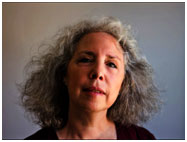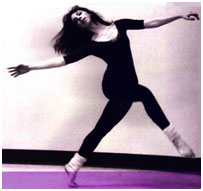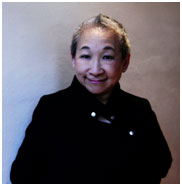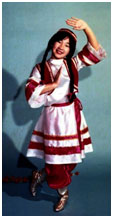Dancers Over 40 ARTS Legacy

SASHA SPIELVOGEL
What inspired you to be a dancer? Like many young girls I started dancing lessons at an early age and adored my ballet teacher, Lynn Netzer. It was then that I met Carol Burnett and Cyril Richard, who were rehearsing for shows at the Shubert Theater in New Haven down the block from where I studied with Lynn. Imagine how starry-eyed I was! The idea of being a princess must've added to the allure with pink tutu's and swan feathers, although I was quite a tomboy. I also loved riding horses and was obsessed with having one of my own. I think the physical freedom of dancing and riding were both like flying and with them I entered a whole new realm of existence. Feeling free and out of the daily school routine was exhilarating. It certainly beat Math! I saw Leslie Ann Warren dance and sing in Cinderella and Mary Martin as Peter Pan on television and Julie Andrews as Mary Poppins in the movie theater. (I was excited to learn, from reading his answers to these questions, that DO40 member Harvey Evans was in the movie!) All of these things were magical and eminently worthy of imitation in this child's imagination. Who was the most influential in your career? Unlike many of the members of D040 who were in shows on Broadway, I come from a classical Modern Dance background. My first serious modern dance teacher in New Haven was Ernestine Stodelle who had been Jose Limon's partner and had danced with Doris Humphrey. When I went to Skidmore College I leaned more about the esthetics of Martha Graham and Jose Limon. Unfortunately, Jose died while I was a freshman and I still clearly remember the day our teacher told us the news of his passing. I never got to study with him but I did take class with members of his company. Both Graham and Limon remain close to me as does their magnificent body of work which was dramatic and heroic, complete with gravitas, and gripping to watch; these artists were giants to me and I thought all of dance was, or should be, like this. Dance became my medium because of these choreographers and because I, too, wanted to tell stories to move people. As a performer I was too shy to speak in public and can't sing, so Musical Theater wouldn't have been a good match and I didn't have to sing in the Modern Dance world. I also find much of post-modern dance, downtown dance, contemporary dance or whatever you want to call it, abstract, frivolous, unstructured and often without good technique or line, which is why I am increasingly drawn to the choreo-graphy and choreographers in Musical Theater which after all, takes the best elements of Concert Dance, Jazz and Ballet and weaves them into a humanistic story. What teacher had the most influence on your career? I never really had a mentor or someone who took me under their wing (which I craved and missed) in my formative years. But I trained with a lot of inspiring teachers, members of the Paul Sanasardo Company, during a summer workshop in Saratoga Springs in the early 70's. One of the teachers with whom I later danced, Diane Germaine, and several fellow students have remained life-long friends. I also studied with Carla Maxwell and Nina Watt at a summer Limon Intensive and with Lucas Hoving at the American Dance Festival at Connecticut College before the festival relocated in Durham, North Carolina. I came to NYC in 1974 and graduated from what was then called University Without Walls at NYU (now Gallatin School of Individualized Study), where I was able to study at Tisch School of the Arts as well as private studios in the city with Byron Mitchell, Don Farnsworth, Nanette Charisse, at the Morelli studio on 14th Street and 6th Avenue and with Maggie Black. I also studied extensively at the Graham school in the wonderful old town house on East 63rd Street before it was torn down, but that is another story. What was the most memorable experience in your dance career? I created NOOR, a 40 minute solo for Felicia Norton (whom I met that summer in Saratoga Springs), based on the life of Noor Inayat Khan, a sufi pacifist who became a spy for the allies during World War ll, was captured by the Nazis and shot in Dachau. A beautiful moment was when we performed the piece in Noor's family home in Suresnes, a Paris suburb. My husband and daughter (who reads one of Noor's stories on the soundtrack) accompanied us. I remember how the audience simply stood in reverential silence for several minutes to honor our performance and to honor Noor. It was transcendent! Another moment was standing in the wings during the finale of Come Back Once More So I Can Say Goodbyeat the Alvin Ailey Theater. The dancers who danced the part of people we knew who died of AIDS were all dressed in white; everyone looked so otherworldly. There was that moment of silence at the end, then the curtain call began. When it was my time to enter, I took a breath and came out to bow before a standing ovation, the audience cheering with tears in their eyes. Can't beat that. This was the most difficult project I had ever worked on, but worth the entire struggle it took to produce it. Thank you John Sefakis and D040, for making this project happen. What would you tell younger generations? Because this profession ain't an easy one emotionally and physically, which we all know, and supporting yourself is really hard, it's important to just keep going because you wouldn't be happy doing anything else in the whole world. If mulling over perfecting dance steps, the timing, the music, wondering whether you've expressed yourself to the best of your ability, if everything tells the story in just the right way and All of That Jazz is what keeps you up at night, then this is for you, and welcome to the club! We are simply wired this way! We have received this blessing/curse to be a dancer or choreographer and should honor our calling, crazy though it may be. No matter which dance aesthetic speaks to you, ours is a truly noble and unique profession. Work on yourself, respect the fact that you were destined to do this. Keep growing, keep learning, keep open. It's so easy to close down, because this life is really hard! Be true to your original impulses and take everyone else's opinion with a large grain of salt; it's generally their own ego or agenda talking. Much easier said than done, but necessary for survival. Be yourself, give yourself the chance and go for it! Leap over the pitfalls and sashay around the nay-sayers! MERDE for your journey! |
LORI TAN CHINN
What inspired you to become a dancer? Patrick Adiarte – I saw him on the television show, “Hullabaloo”. It was the first time I saw an Asian dancing on TV. Seattle, WA was considered a “log town” at the time. There were no Starbuck’s coffee stands, no grunge bands, no survivalist groups (at least, I never heard of any organized). The glamorous career path for females upon graduation - if they even went to college – was to get in, take general courses, then quit when they found a potential husband. Or, get trained to be a stewardess, and maybe find a husband through the “coffee, tea, or me” method of exposure to the eligible, rich male passengers. The only dancing were the local dance schools, which had recitals in the summertime. My parents were from China, with us American-born Chinese children going to the local public school. Pursuing a career in the performing arts was never an option, though my father had been a watercolor artist in China, but had to give it up when he came to America, to find his fortune in what the Chinese called: “The Gold Mountain” (stories that the streets in America were paved with gold, drew hundreds of Chinese to the shores of America). I loved to mimic the dancing I saw on the TV shows, and, after seeing someone on TV and movies wholooked like me, led me to dream about a career in dance. I had no formal dance training. I learned the ballet positions from a book at the neighborhood public library – the kind of book with the footprints and dashes, to show where the feet should be placed next.
Carmen de Lavallade – when I saw her dance on a program on television, I was hooked. Her dancing was so fluid, all-encompassing. I wanted to be her! She was the symbol of all I wanted to be as a dancer. Her modern dance technique, I discovered, was Lester Horton, and when I came to NY, I found the wonderful James Truitte (original member of the first Ailey company), teaching this technique. What teacher(s) had the most influence on your career? Ruthanna Boris (Balanchine’s first company, then the Ballet Russe de Monte Carlo) – she was the head of the Drama Department at the University of Washington. A tough, stern, short (my height!), exact New Yorker who taught a group of us selected dancers in a barn, without a mirrored wall in front of us – we were trained to find our centers within our minds and bodies, and not rely on constantly checking or admiring our bodies in the mirror. We learned Russian ballet technique and wore the ballet slippers with the hard, leather soles; What was the most memorable experience you can remember? The first show I auditioned for, I landed a role in the chorus of the new musical, “Lovely Ladies, Kind Gentlemen” (a musical version of “Teahouse of the August Moon”). From there, my antics in the chorus caught the attention of the director, Larry Kasha, and in Philadelphia, the first leg of the Broadway-bound tour, I was plucked out of the chorus to become the comedic lead actress in the show. While in Los Angeles, a ghost choreographer came aboard for about a few weeks – Ron (“Cabaret”) Field. He choreographed a 5-minute ballet for me and our romantic lead, Ron Hussman, as well as, changed 2 other dance numbers for me. I was scared outta my wits, but ready for the challenge. He stopped me in the hall and told me, “I’m going to make you a star.” This was right after he had made Bonnie Franklin a star in “Applause”. Do you have a most frightening or funny dance experience you can remember? During a performance in “Lovely Ladies, Kind Gentlemen”, I had a habit of snapping the elastic to my dance belt, before standing up and leading my fellow villager ladies into a slow, traditional-looking Japanese fan dance, that broke into a can-can, with high kicks. This time, there was no snap from my dance belt! I was wearing nude, sheer tights, with no underwear under the tights, and NO DANCE BELT OVER THE TIGHTS! I have never been able to duplicate that nervous laugh, when having to turn and do the high can-can kicks, knowing the front row of the audience, as well as, however few hetero male performers we had onstage, would get a full muff view – Japanese geisha in hysterics. What experience or legacy would you like to pass on to the next generation? Nowadays, I am seeing so many new styles of dance. I will be working on an upcoming show, bound for Broadway, where the cast members are all seniors, over age 60, and we are learning hip hop for the show. We have hip hop teachers, but most who have taught us, do not give a long enough warm-up for these slower-moving bodies. When these young bodies begin to slow down from their flips, gyrations, and turns, I guarantee them that the pains will be severe. Please, please take the extra time to warm up correctly. Please, please, also take the time to find out our history. Aside from the voice, and the proper placement of it, to support the acting, the single most important element is to be physically able to be the best you can be. The professional directors, musical directors, etc. cannot express their best without us, the best physical instruments, who carry out and bring their realizations to full fruition, if we don’t take care and be kind and supportive of each other. You will know what I’m talking about by the time you reach the age of a dancer over 40, and beyond. | |


 Although I danced with several choreographers way back when who, I always say are either dead, have stopped working, or moved out of town, I really became a choreographer early on and the dancers I work with are technically more proficient and certainly skinnier than I ever was! It may sound corny, but every time a dance of mine is performed and they are your children after all and the birth process often painful and actually quite a nerve-wracking experience. I'm sure everyone has experienced this - right before you perform, or have a piece shown, you just want to die or throw up, because it means so very much to you. There are always those questions: will the audience get it, will they like it, should I care if they do or if they don't like it, will the dancers remember their steps or bang into each other!! Then you get into the zone and are one with your creation, if your neighbor isn't rattling their program. Finally, when it's all over, there is that feeling of total release and exhilaration - most of the time.
Although I danced with several choreographers way back when who, I always say are either dead, have stopped working, or moved out of town, I really became a choreographer early on and the dancers I work with are technically more proficient and certainly skinnier than I ever was! It may sound corny, but every time a dance of mine is performed and they are your children after all and the birth process often painful and actually quite a nerve-wracking experience. I'm sure everyone has experienced this - right before you perform, or have a piece shown, you just want to die or throw up, because it means so very much to you. There are always those questions: will the audience get it, will they like it, should I care if they do or if they don't like it, will the dancers remember their steps or bang into each other!! Then you get into the zone and are one with your creation, if your neighbor isn't rattling their program. Finally, when it's all over, there is that feeling of total release and exhilaration - most of the time.
 Who was the most influential in your career?
Who was the most influential in your career?